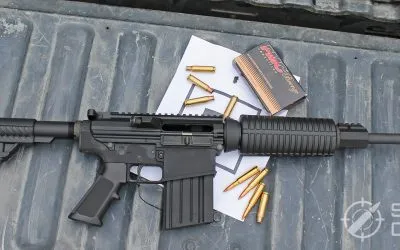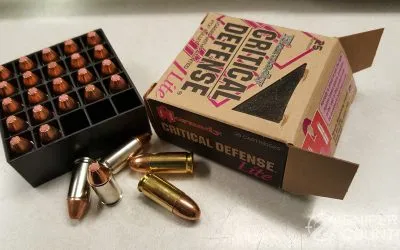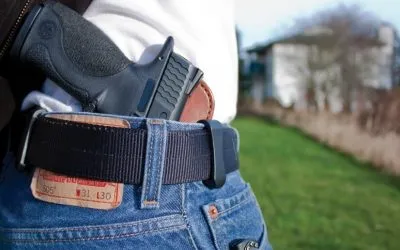Kimber’s Origins
The following details might be more extensive than expected, but they shed light on the challenges Kimber has overcome to become the renowned firearm manufacturer it is today. My investigation revealed some intriguing details. Founded in 1979 as Kimber of Oregon by Jack Warne and his son Greg, the company was based in Clackamas, Oregon. Jack Warne, originally from Australia, had been involved in the sporting goods sector in his home country until Portland-based Omark acquired his business. He then moved to America, specifically to Oregon. Kimber of Oregon quickly earned a reputation for crafting high-quality .22 LR rifles—something I recall vividly when they first hit the market. They created a significant buzz and were priced higher than the typical .22 rifles of that era. The metalwork was exceptionally polished, and the stocks featured some of the most beautifully figured hardwood I had seen on any .22 rifle. Around this time, Kimber also acquired the Brownell quick-detachable rifle scope mount to pair with its rifles and opened a second manufacturing facility in Oregon.The Troubles Begin
In the late 1980s, the company aimed to launch a big game rifle, the M89 BG. To fund this new venture, they issued a stock option, but it didn’t fully cover the costs associated with the rifle’s introduction. Consequently, in 1989, the company was sold to Bruce Engel, a prominent figure in the lumber industry and the founder of WTD Industries, Inc. Engel faced difficulties managing Kimber, which eventually led the company to seek bankruptcy protection. The assets of Kimber of Oregon were subsequently liquidated.Exodus
In 1990, several Kimber employees departed to establish a new company named Cooper Firearms of Montana, led by former Kimber staff member Dan Cooper. Shortly after, in February 1991, co-founder Jack Warne left to create Warne Manufacturing Company. This new venture developed a rifle scout mounting system that, based on available information, appears to have been quite well-crafted.Kimber Of Oregon Is Re-Born
Greg Warne attempted to revive Kimber, but much of the necessary tooling and machinery had been discarded (they were discovered in a dump north of Portland) and were in poor condition. Enter a benefactor: Les Edelman, owner of Nationwide Sports Distributors. With Edelman’s financial support, he and Greg established a new entity called Kimber of Oregon. However, in a surprising turn, Edelman forced Greg Warne out of the company after acquiring a majority stake. It appeared the Warnes were facing continuous setbacks. After his departure from Kimber, Greg moved to San Pedro, Costa Rica, where he crafted custom handgun grips from local exotic hardwoods. He passed away in 2006. MeanwhileUNew York, New York...
Another investment that Edelman had made (in addition to Kimber) was with the Yonkers, New York-based company Jericho Precision Manufacturing. They were largely building tools and items for the military. Edelman’s substantial ownership in Jericho enabled him to move Kimber’s operations from Oregon to New York. This strategic relocation combined Jericho’s manufacturing expertise with Kimber’s established reputation and distribution network, paving the way for the production of 1911 pistols.Yet Another Setback...
In December of 2004, Kimber Manufacturing/Nationwide Sports Distributors chief financial officer Denis Shusterman was indicted by a Federal grand jury of embezzling $10 million from the two companies. He pled guilty, was convicted, and was ordered to pay damages and back taxes. In addition, he was sentenced to more than ten years in prison. So, Kimber’s troubles continued.Today’s Products
Kimber has weathered all these storms and is back, stronger than ever. On October 21, 2020, Kimber officially established its corporate headquarters in Troy, Alabama. In addition to 1911-style pistols, Kimber also makes a slick little striker-fired, metal-framed 9mm called the EVO SP and a six-shot snub-nosed .357 Magnum revolver, the K6S. They make several variations of each of those guns – they seem to be very popular, at least around here. I learned an awful lot as I researched Kimber’s history. I had no idea that they have had such an “interesting” history. I am impressed with the fact that, like the Phoenix, the company kept rising and rebuilding. Not from ashes, but from legal entanglements, buy-outs, machinery dumped in a landfill, etc. Another thing that impresses me is the fact that their products have a reputation for being of very good quality. That speaks volumes in itself. Whether or not you’re a Kimber fan, the brand’s products seem to carry prestige.BONUS OFFER: Get your free shooting range targets to print at home!
Get your free targets to print at home!
Now...The Micro 9
Let's dive into the details of the Micro 9. I borrowed one from my friend Duane’s gun shop—a lightly used two-tone Micro 9 that he kindly lent me. This particular model is an NRA special edition, with the serial number beginning with "NRA." The aluminum slide offers a striking contrast against the blued slide, and the rosewood grips add an elegant touch, in my opinion. We'll explore other variations later, but for now, here is the one I shot:
 First, let’s get a few facts and figures out of the way. The Micro 9 is a small 1911-style single action, single-stack sub-compact 9mm. It does differ from a traditional 1911 in that it has no grip safety, no barrel bushing, and uses a non-swinging-link barrel but in most other aspects it is similar to that type of pistol. If you are a 1911 fan, you should like this handgun. Let’s look at its specifications.
First, let’s get a few facts and figures out of the way. The Micro 9 is a small 1911-style single action, single-stack sub-compact 9mm. It does differ from a traditional 1911 in that it has no grip safety, no barrel bushing, and uses a non-swinging-link barrel but in most other aspects it is similar to that type of pistol. If you are a 1911 fan, you should like this handgun. Let’s look at its specifications.
| Caliber: | 9mm |
| Frame: | Aluminum |
| Slide: | Steel |
| Weight: | 15.6 ounces (with empty magazine) |
| Height: | 4.1 inches |
| Length: | 6.1 inches |
| Width: | 1.06 inches |
| Recoil Spring: | 11.5 pounds with full-length guide rod |
| Barrel: | 3.15 inches, stainless steel |
| Sights: | Three-dot metal sights, dovetailed (night sights available from Kimber) |
| Safety: | Thumb, left side only -- not ambidextrous |
| Capacity: | one 7-round magazine (flush fit 6- and extended 8-round magazines available) |
| Grips: | Rosewood (Crimson Trace available from Kimber) |
| Trigger: | Solid aluminum, approx. 7-pound pull weight |
| Action: | Single (1911) |
| MSRP: | $654 |
| Real-World: | approx. $550 |
Micro 9’s Predecessor
When you pick up the Micro 9, you can tell pretty quickly that it was derived from a similar gun, if you are familiar with Kimber’s products at all. That first gun is the Kimber Micro .380. The .380 is almost a twin of the Micro 9, except for the obvious difference that it is a gun chambered for the .380 ACP cartridge. Introduced in 2014, the Micro .380 is very similar to the Micro 9 but is approximately 3 ounces lighter. Aside from this weight difference, their dimensions are quite comparable. Kimber aimed to enter the single-stack sub-compact 9mm market, so they made some adjustments and introduced the Micro 9 in 2016. An interesting thing to mention is that the Micro .380 comes with two magazines, a 6-round and a 7-round. The Micro 9 comes with one magazine, a 7-round. A lot of concealed carriers (Best CCW insurance comparison) are OK with buying a second or second-and-third mag for the Micro 9 since (at least one of) the magazines included with each gun can hold an equal number of rounds (7) They figure that the 7 rounds of 9mm is more powerful than 7 rounds of .380 ammo, so why not buy the Micro 9? You can buy 6- and 8-round mags for the Micro 9, as well. I would think that the popularity of the 9mm cartridge for concealed carry would just about spell the end of sales for a less-powerful gun so similar that you can’t really tell them apart side-by-side, but I would be wrong. At last check of Kimber’s website, the different-finish-or-other-variation count for the Micro 380 is eleven, while the Micro 9’s count is sixteen. It would seem that BOTH pistols sell well for Kimber, or there wouldn’t be so many variations. Let’s look at the individual components of the Micro 9 and then we’ll talk about shooting it and other factors.Popular Articles
The Micro 9 Up Close & Personal
Cardboard? What?!?
The appearance of the Micro 9 is clear from the photos above, so there's no mystery about its look. I'll cover how it appears when field-stripped for cleaning shortly. But first...what kind of container does it come in? How do you carry it around (Best Concealed Carry Holsters)? Kimber ships the Micro 9 in a cardboard box. While some YouTube “experts” criticize cardboard boxes for pistol shipping, many of them make a valid point: opting for a simpler box allows the manufacturer to invest more in the quality of the firearm itself. I agree with this perspective. Although I appreciate the hard plastic cases that came with several of my firearms, I still have my 1980s Smith and Wesson Model 629, which arrived in a cardboard box. This was during an era when wooden presentation boxes were used for their high-end Magnums. I suppose the deer it has taken over the years don’t mind that it was shipped in a cardboard box. Kimber does include a stylish double-zippered pistol rug to protect the gun from scratches during transport and storage. They likely assume that if you can afford one of their pistols, you can also purchase a hard plastic or metal case from a local store. I also concur with this approach. Below are images of the box and the double-zippered soft carry caseU
 Now...on to the gun...
Now...on to the gun...

 Frame, right side. Notice the engraving over the trigger and the serial number. This is an NRA special edition. The solid aluminum trigger pivots on a pin (above it) - it does not go straight back like that of a traditional 1911.
Frame, right side. Notice the engraving over the trigger and the serial number. This is an NRA special edition. The solid aluminum trigger pivots on a pin (above it) - it does not go straight back like that of a traditional 1911.
 Frame, left side. Note the extended thumb safety and the ejector – more on this later. There is a spring that holds the slide stop when it’s inserted...it is visible right above the trigger.
Frame, left side. Note the extended thumb safety and the ejector – more on this later. There is a spring that holds the slide stop when it’s inserted...it is visible right above the trigger.
 A close-up of the hammer, beavertail and ejector. No slide- or hammer-bite for me with this gun.
A close-up of the hammer, beavertail and ejector. No slide- or hammer-bite for me with this gun.
 Slide with laser engraving and serrations.
Slide with laser engraving and serrations.
 Engraving close-up
Engraving close-up
 Barrel, recoil spring and feed ramp (below)
Barrel, recoil spring and feed ramp (below)
 OK, you get the idea. Let’s look at some things that I really like about this gun, and two areas that I think could be improved upon.
OK, you get the idea. Let’s look at some things that I really like about this gun, and two areas that I think could be improved upon.
I Like The...
Sights
I really like the sights on the gun. They’re metal and set in dovetails, which means you can replace them if you prefer something different. But what I like about the ones on the gun is that you can see the white dots. This statement pre-supposes that you LIKE white dots...if not, there’s always my “sight-white-dot-fixer-tool", a Sharpie...

Grip and Grip Panels
I have a particular fondness for the rosewood grip panels. I suppose I’m a bit old-school in that regard. My shooting days began when it was common to swap out grip panels on a pistol or revolver for those made from different types of wood or materials. Nowadays, most polymer-framed pistols come with built-in grip texturing, making exotic hardwood grips less common. These rosewood panels are not only attractive but also meticulously laser-etched, combining both style and functionality. Of course, there are alternative grip options available if you prefer something different. Grip close-up. Note laser engraving and hex-head screws.
Grip close-up. Note laser engraving and hex-head screws.
 Backstrap “checkering”
Backstrap “checkering”
Magazine
I appreciated the 7-round magazine that came with the gun. It was relatively easy to load, and I experienced no malfunctions with it. The numbering on the side is clear and visible, though I had difficulty capturing a good image of the logo at the bottom due to the magazine’s reflective steel finish. The magazine is marked with “Kimber,” so there’s no chance of confusing it with another brand. The base pad provided a good place for my little finger to rest during shooting and helped ensure a secure fit when seating the magazine in the well. Overall, it's a well-designed and functional magazine. OK...what’s not to like? There were only two things that I noticed about this gun that, if I were Kimber, I might take a look at. The first thing? The magazine well. Take a look at this photo:
OK...what’s not to like? There were only two things that I noticed about this gun that, if I were Kimber, I might take a look at. The first thing? The magazine well. Take a look at this photo:
 Notice the front two “points” in the photo? I nearly cut my thumb open while trying to remove the magazine from the well manually, rather than using the mag release button. These areas are quite sharp, sharper than the photo suggests. Kimber might want to reconsider these edges. While precise lines and angles are appreciated in a pistol, especially a 1911-style, there can be too much of a good thing. A bit of polishing on these points wouldn’t compromise the function of the well but could prevent potential injuries.
The second thing that Kimber needs to address is the magazine. Yes, I wrote above that I really liked the ONE that came with the gun – for an MSRP of over $650, you should get THREE magazines – one each 6-shot, 7-shot and 8-shot. There is no excuse for not doing that. Even lesser-expensive guns from makers like Glock, Springfield Armory, Ruger, Smith & Wesson and Taurus come with two or three magazines. Kimber makes and sells (on their “Shop” page) four different mags for the Micro 9 – a 6-shot, 7-shot, 8-shot and a 7-shot with a Hogue grip extender for an average price of about $36 each...Kimber, get with the program!
Other than those two items, I like the gun. It feels solid in the hand and generally shoots where it looks (except that my shots all went to the right as you will see, but that’s me and not the gun as I’ve found out from shooting several other guns. The gun itself was great).
Notice the front two “points” in the photo? I nearly cut my thumb open while trying to remove the magazine from the well manually, rather than using the mag release button. These areas are quite sharp, sharper than the photo suggests. Kimber might want to reconsider these edges. While precise lines and angles are appreciated in a pistol, especially a 1911-style, there can be too much of a good thing. A bit of polishing on these points wouldn’t compromise the function of the well but could prevent potential injuries.
The second thing that Kimber needs to address is the magazine. Yes, I wrote above that I really liked the ONE that came with the gun – for an MSRP of over $650, you should get THREE magazines – one each 6-shot, 7-shot and 8-shot. There is no excuse for not doing that. Even lesser-expensive guns from makers like Glock, Springfield Armory, Ruger, Smith & Wesson and Taurus come with two or three magazines. Kimber makes and sells (on their “Shop” page) four different mags for the Micro 9 – a 6-shot, 7-shot, 8-shot and a 7-shot with a Hogue grip extender for an average price of about $36 each...Kimber, get with the program!
Other than those two items, I like the gun. It feels solid in the hand and generally shoots where it looks (except that my shots all went to the right as you will see, but that’s me and not the gun as I’ve found out from shooting several other guns. The gun itself was great).
Ergonomics
Speaking of how it feels in the hand, what about the “ergo factor” of this gun? It’s a 1911 that just about fits in one hand, for Pete’s sake, so how does it handle? When held in a two-hand, thumbs-forward grip, the gun just fits. Being left-handed, I had no issues of “riding the slide stop” that some of you other 90% of shooters (righties) experience at times when shooting 1911s. My right thumb indexed every time on the slide stop pin’s protrusion from the right side of the frame. (The pin’s protrusion was very minor and was not in the way at all). This setup provided a consistent grip for my shooting style. Coupled with the checkering on the grip panels and back strap, the gun stayed firmly in my hands. The sights were easy to see, even for my aging eyes, making for an enjoyable shooting experience. There was no hammer bite or any other discomfort—just a compact 1911 without a grip safety, shooting an effective cartridge. So, how did it perform in action?BONUS OFFER: Get your free shooting range targets to print at home!
Get your free targets to print at home!
Shooting The Micro 9
During my shooting sessions with the Kimber, I tested three different types of ammo. I used two (what would be) practice loads with FMJ bullets, and a self-defense JHP load just to see if there might be any hesitation at all on the Micro 9’s part to feed such ammo. I shot 5-shot groups at a measured seven yards. I later shot over my Caldwell chronograph to determine velocities. I put the front sight directly in the center of the white square for all shots – no 6 o'clock hold here. Here’s how it came out, with representative targets for each load...
The Ubiquitous “Winchester White Box” 115-Grain FMJ; 1032 fps
As you can see, my 5-shot group is looking a bit like the Big Dipper, but without that constellation’s orderliness. I did not have much luck with this round in terms of accuracy. As I said before, I didn’t expect it to shoot to point-of-aim (which it did not) but I was sort of hoping for a little more “togetherness” in the groups. As disappointed as I was with the groups, I was fairly happy with the velocities that the WWB ammo turned in. As you see, it averaged 1032 fps, which was faster than either of the other two types of ammo I tried. We have to remember that these bullets are emerging from a 3-plus-a-fraction-of-an-inch barrel, not a five-inch service pistol tube, so I was happy with this velocity. My second practice load was from Perfecta.
Perfecta 115-Grain FMJ; 986 fps
The Perfecta ammo performed somewhat better than the WWB, but it still didn’t meet my accuracy expectations given the 7-yard range. I selected these two practice rounds because they are popular, cost-effective choices bought in bulk from big box stores. Each grid square on my homemade target is an inch, giving you an idea of the group size. In terms of group size, the accuracy of the Micro 9 with this load was sufficient for range practice and should roughly reflect both the point of impact and recoil of the self-defense JHP ammo used by shooters. (It did exhibit some recoil.) I found this to be true, at least in comparison with the self-defense load I tested (shown below)—the Perfecta load was fairly close in terms of impact and recoil compared to the Remington load. I encountered no feeding or shooting issues with either practice load. This brings us to the self-defense load I chose to testU
Remington 115-Grain HTP; 1006 fps
In my article on the best 9mm defense ammo, I mentioned at least one Remington load. I had some of their excellent HTP rounds in my ammo box so I thought I’d try that and see what might happen. As shown, the group size isn’t stellar but isn’t terrible either. With some sight adjustments and additional practice, I believe I could get all the shots into or at least close to the center square from 7 yards or beyond. Considering this was my first time shooting the gun, I’m confident I could improve with more experience. This load performed well in ballistics gel—here’s a screenshot from the Lucky Gunner.com gel test: As shown, the penetration is substantial, and the bullet’s expansion is adequate. I wouldn’t feel under-armed with this ammunition. The Kimber handled it well—there were no feeding or ejecting issues with this or any other loads. You can read more about this particular gel test here. After looking at the long, polished feed ramp connected to the Micro 9’s barrel, it’s no wonder I didn’t have any function problems with it. I wanted to try a handload or two with different types of bullets, but since I didn’t own the gun, I did not test my home-made loads. For practice, almost any RN (round nose) FMJ or TC (truncated cone) FMJ bullet load should work fine. But – what type of practice ammo, let alone defense ammo, should you buy?
As shown, the penetration is substantial, and the bullet’s expansion is adequate. I wouldn’t feel under-armed with this ammunition. The Kimber handled it well—there were no feeding or ejecting issues with this or any other loads. You can read more about this particular gel test here. After looking at the long, polished feed ramp connected to the Micro 9’s barrel, it’s no wonder I didn’t have any function problems with it. I wanted to try a handload or two with different types of bullets, but since I didn’t own the gun, I did not test my home-made loads. For practice, almost any RN (round nose) FMJ or TC (truncated cone) FMJ bullet load should work fine. But – what type of practice ammo, let alone defense ammo, should you buy?
How To Select Ammo For The Micro 9 – A Quick Primer
I’ve identified two main criteria for selecting practice ammo, assuming you’ve already chosen and practiced with your preferred defense ammo. For guidance on selecting defense ammo, you might refer to my article on the best 9mm ammo (link above). Once you've settled on your carry ammo, the practice ammo you choose should meet the following two criteria:- Similar point of impact on the target as your carry ammo – remember that the shorter the barrel, the greater the variance in terms of point of impact between guns and loads. The Micro 9 has a 3.15-inch barrel, pretty short for a 9mm.
- Similar velocity.










![9mm Glock Models [Ultimate Guide]](https://snipercountry.com/wp-content/uploads/2018/10/Glock-17-vs-Glock-19-vs-Glock-26-vs-Glock-41-vs-Glock-43-WM-400x250.webp)
![Handgun Caliber Chart [2025 Ultimate Guide]](https://snipercountry.com/wp-content/uploads/2018/10/Handgun-Caliber-Comparison-400x250.webp)
![Rifle Calibers [Ultimate Guide]](https://snipercountry.com/wp-content/uploads/2018/12/Header-1900-400x250.webp)







16 Responses
Great article. Have a micro 9 nightfall. Had to go back to the factory for multiple failures to eject. Runs fine now. Shoots great. Could shoot it all day.
Jim, glad they figured it out for you, and glad that it is now reliable. Thanks for writing!
I love mine, I have the same weapon that you tested. My only criticism is the coatings. I carry in a Crossbreed IWI Super Tuck and the upper coating has worn off and the coating on the lowered is rubbing off. Other than that, it’s my favorite pistol I can shoot a quarter at five yards consistently after I broke it in. Great article.
James, too bad about the finish – I think you’re the first one to tell me about it. Great marksmanship, too – good job! Thanks for writing.
Dropping down to Micro 9 from my 3 inch 911 kimber was a thought out process, from a spring, winter, fall conceal to the smaller Micro 9 for summer. It has worked well. The Micro 9 conceals well with summer attire and it really does well at the 7 to 10 yard self defense circle. Being a retired Deputy Sheriff from a large department, I still practice a lot, and use not only body shape targets, I use the hostage target more. I am pleased with this smaller 9 mm.
Ken, yeah, I could see it as a summer carry gun. It’s great that you can practice as often as you do. Thanks for writing!
Bought the Kimber Mirco 9 for my wife because they were both so beautiful. Prove to be a too much gun for my wife’s small hands so I had to add to my collection. Two comments: I increased handling by replacing the beautiful Rose Wood grips with Hogues and purchased extended 7-round mags so I had a place for my pinkie finger. Second I had a few FTF with 115 g ammo, but fixed that with 124 g.
Curtis, glad you figured the ammo out. Some just works better than others. Thanks for writing!
Nice review Mike…..Detailed and thoughtful……Thank you
I disagree 100%, however, on the cardboard box issue. I just received a K6S TLE and was very disappointed in the cheap cardboard box. I expected more from a $900 gun. I travel by plane, occasionally, and have to use a SIG SAUER box from my P365 with the K6S. Kimber should do better on such a pricey gun. A $249 Taurus, I get it.
Alan, I can see your point, but evidently Kimber is trying to cut corners where they can. A more-substantial box probably wouldn’t add much to the cost of the gun, something maybe they should consider. Thanks for writing!
Good detailed review. I recently bought the stainless version and really like it. Only put 200 rounds through it so far, but haven’t had any issues whatsoever. Shot both 115 grain and 124 grain. I paid $599 for the stainless version, but guns seem a little higher since the pandemic and riots.
I have two more 7 round magazines on the way.
Thanks for taking the time to do a review of this gun !
Keith, glad you like it – it’s a very well-built gun. Hope you can find ammo to practice with! Thanks for writing.
Nice review. but wish I could say the same for my Micro 9. Sent to Kimber twice. Has a FTF (nose down) with any JHP. the first time they adjusted the ejector and polished the ramp which seemed to make the problem worse. The second time Kimber said they could not duplicate the malfunction, which is B.S. Anyway 2,200 rounds and still trying.
Gary, too bad. Did it ever straighten up? Thanks for writing.
I have the Kimber Ultra CDP II 45ACP. When I first got it I had several failures to feed after firing 3 or 4 shots without a jam. I returned it to Kimber who determined the fault was a bad mag and they replaced it. But I continued to have jams so I took it to a gunsmith who polished the ramp but I still had problems. Took it to another gunsmith who filed the ejector pin and no more jams. I am considering buying the Kimber Micro 9 but am concerned about failur to feed problems.
Bought the Micro 9 Black Ice. The good. No feed problem on FMJ and JHP. Love the Truglo site and the dovetail back strap. I am a high, tight grip lefty with large hands. The pinky mag extension helps return to target faster. Finally, the trigger travel is very short and the release is crisp. Now the bad. First, finish failed almost instantly. Heard this is a problem..but literally chipped in 28 rounds with 3 leather holster draws! Then there is the trigger pull. I know safety requires stiff triggers but 7.5lbs is horrible. If they cut 1.5 lbs out of that pull then I wouldnt even think of trigger job..but that should be your first upgrade. Next is the double safety. As a left I love it..however, to set it requires some force. You cant set it with a single thimb but you can release it with one, but be careful because the safety poor thumb position after release of safety could result in a little bite from the slide. Lastly, blowby. The gun gets dirty quick. I do a quick field cleaning after every shoot. The micro 9 looks like you fired 100s of rounds out of it in a 40-50 round shoot. I go through about 20 cleaning swabs after shooting a box of ammo. I go through about 10 on my full size 1911 after shooting same number of rounds. I definitely wouldnt fo without cleaning it after each event.